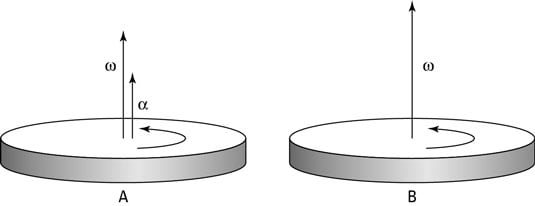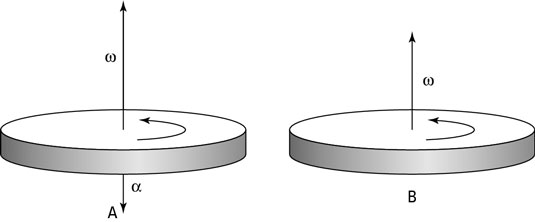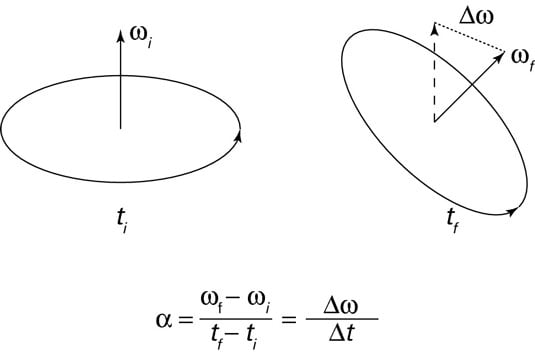If the angular velocity vector points out of the plane of rotation on a wheel, you can use physics to determine what happens when the angular velocity changes — when the wheel speeds up or slows down. A change in velocity signifies the presence of angular acceleration. Like angular velocity,
angular acceleration,
is a vector, meaning it has a magnitude and a direction. Angular acceleration is the rate of change of angular velocity:
For example, look at the first figure, which shows what happens when angular acceleration affects angular velocity.

In this case,

Just as an object’s linear velocity and linear acceleration may be in opposite directions, the angular acceleration also doesn’t have to be in the same direction as the angular velocity vector (as diagram A in the next figure shows). If the angular acceleration is directed in the opposite direction of the angular velocity, then the magnitude of the angular velocity decreases at a rate given by the magnitude of the angular acceleration.

Just as in the case of linear velocity and acceleration, the angular acceleration gives the rate of change of angular velocity: The magnitude of the angular acceleration gives the rate at which the angular velocity changes, and the direction gives the direction of the change. You can see a decreased angular velocity in diagram B in the second figure.
The angular acceleration is the rate of change of angular velocity — the change can be to the direction instead of the magnitude. For example, suppose you take hold of the axle of the spinning wheel in the first figure and tilt it. You’d change the angular velocity of the wheel but not by changing its magnitude (the angular speed of the wheel would remain constant); rather, you’d change the direction of the angular velocity by changing the axis of rotation — this is an angular acceleration that’s directed perpendicular to the angular velocity, as in the third figure.

The word instantaneous is used above because, unless
will not be perpendicular to either the initial or the final angular velocity. This type of angular acceleration, which changes the direction of the axis of rotation, is usually not addressed in elementary physics. In fact, when you change the axis of rotation, you change the angular momentum, which introduces precession.

